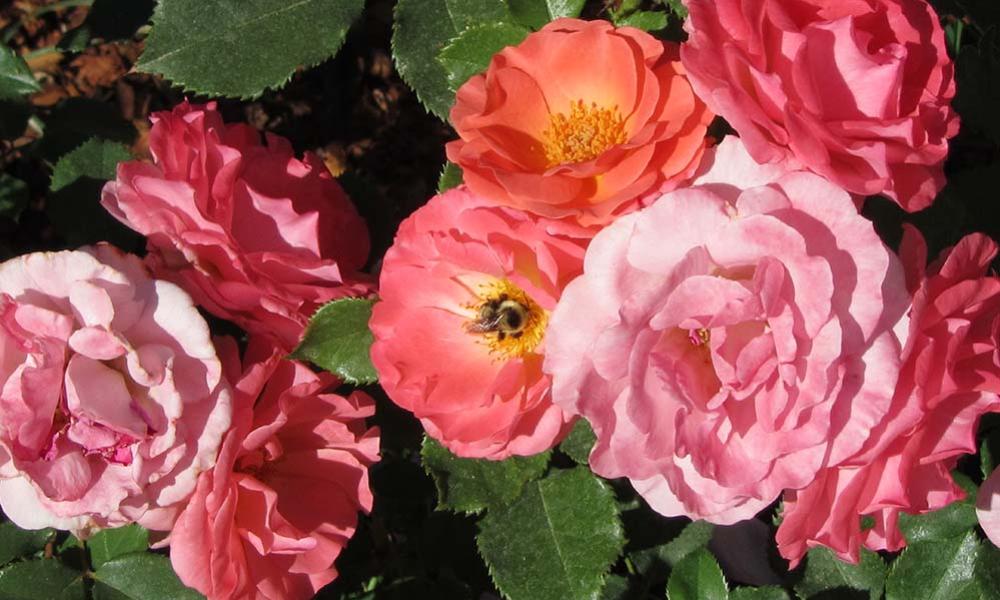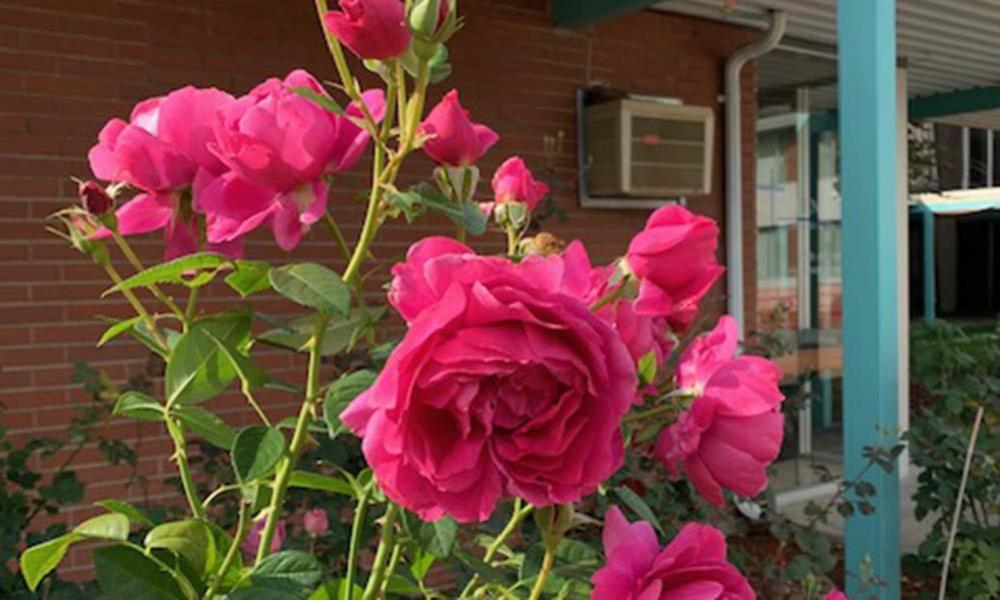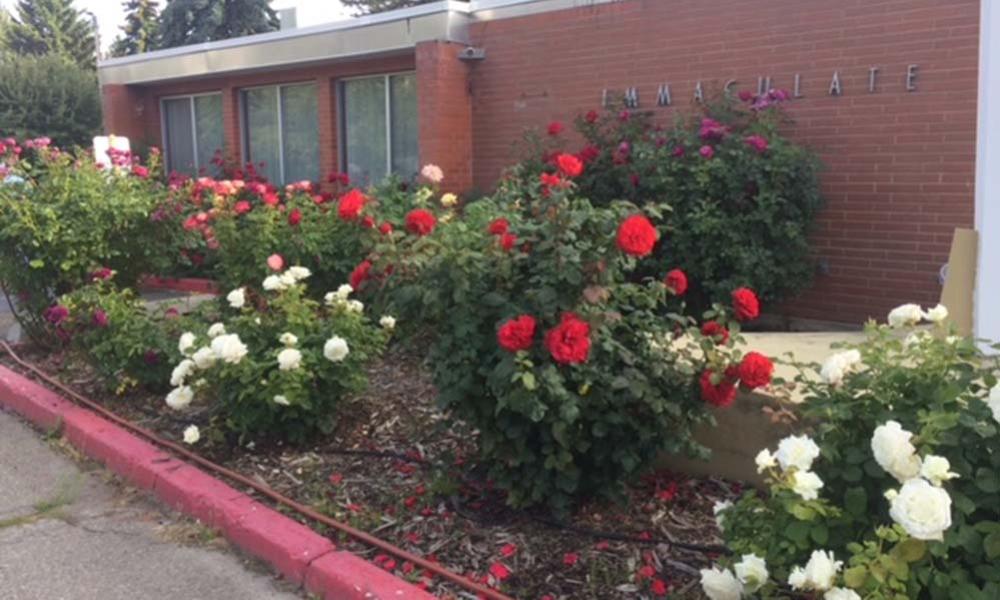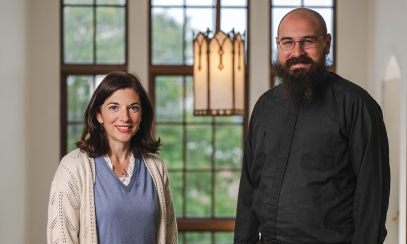
The TLC of Roses at IHRC
If anyone has ever been “caught” up in a rosebush, the lesson learned is that one would never want to be subjected to wearing a crown of thorns! Rose thorns hurt! Apart from their negative side, roses are some of the most beautiful, fragrant, and rewarding flowers to cultivate.
The first roses at Immaculate Heart Retreat Center were planted by Sister Mary Agnes while she was director, more than 25 years ago. When I asked Deacon John Ruscheinsky if I could take over the care of the roses, it was 2002. My mother, a rose lover, had just passed away, and my 91-year-old dad and I planted three roses in her honor in what is now called “The Mother’s Garden.” Four of the original roses planted by Sister Mary Agnes have survived; one we have since dubbed “Resurrection Rose.” It is a beautiful white rose that keeps blooming, even when it seems quite dead. The Mother’s Garden, honoring Mary, mother of us all, and several other mothers, kept growing as each rose was planted to honor a beloved mom. Father Joe Bell chose the rose “Bellaroma” because his mom, Anna, loved yellow and was with him in Rome for his ordination to the priesthood. Gradually, we wrapped roses around the building into what is now “Brian’s Garden,” honoring Brian Prawdzik, son of Deacon Steve Prawdzik. We also created the “Garden of the Beloveds” around the Bishop’s Room and the Bell Tower. The white rose “John Paul II” we planted for Monsignor David Rosage and “Sunstruck,” an orange rose, for Monsignor William VanOmmeren. There are also grandifloras, floribundas, hybrid teas, and shrub roses in the three gardens.
How do Gloria Riedlinger and I give them the TLC they deserve? Like people, roses need sunlight, water, nourishment, and loving care. That is really it. They are hardy and weather adversity well, as they rebound each year to produce beautiful blossoms for the enjoyment of all retreatants and staff. We don’t “pick” them for bouquets, as they last much longer on the vine, which may be another pertinent Biblical analogy; stay connected to the vine and bear much fruit!
Some rose experts prefer to prune down roses to about a foot off the ground in the fall, but we have chosen not to do that. We prune in the spring when the greatest risk of frost is over. We prune out all the dead wood, darkened and black, creating air space within the bush itself. If roses are too tangled with old wood, they do not get the air they need and can become infected with various diseases. We observe each rose carefully. Sometimes what seems like dead wood isn’t…..it has buds on it. We try to cut off all cross limbs, which head inside the bush rather than toward the outside. This also creates air space and makes for a nicer looking bush. Depending upon the severity of the winter, we may need to prune more or less. It is safer to not cut your bushes down more than 1/3 in any given year unless you are forced to do so. Each rose has its own desired height; grandifloras and floribundas tend to be larger and taller than hybrid teas.
Next, we fertilize with a three-part mixture that feeds, as well as repels bugs and diseases.. We fertilize all the roses three times during the summer months. This is the nourishment on which they thrive. t is important to stop fertilizing by early September. We want the plants to go dormant for winter and put their energy into the root system instead of into producing blossoms. It is important to stop deadheading (removing old blossoms) at this same time, as well. o deadhead, simply look down the stem past the decayed blossom until you see a stem with five leaves. You should notice a tiny bud forming at the juncture of the leaf stem. Make your cut just above and diagonally away from the bud so the sap does not run down upon the bud. A new flower will sprout at that point.
Some people use pine needles or mulch to cover the base of their roses. Since we have about 75 roses at IHRC, we really do not use either. However, the brick walls of the building behind the roses provide some shelter.. If you have roses out in the middle of your garden, it is probably better to give them some coverage as protection from harsh winds and freezing cold, although snow can act as an insulator. The most dangerous time for rose damage is in the spring when they start to bud in warmer weather., A sudden late freeze can kill early buds.
Depending upon where you live, you may or may not have a problem with …. deer. As you know, IHRC is home to many of these lovely creatures. They also LOVE to EAT roses! We start spraying our plants with a commercial spray early in May and continue all through the summer.The deer do not like the smell, and we try to spray at night (I imagine the retreatants aren’t crazy about the smell), but it dissipates in about half an hour. Come October, we stop spraying so the deer do not get used to the smell at a time when they are very hungry. We let them chew on the leaves, as it won’t hurt the plants. They will lose all their leaves in winter, anyway. This has been the “compromise plan” we have worked out with our four-footed friends.
Lastly, water, water, water. Roses are always thirsty! They do not like to get water on their leaves or blossoms, but they love to have their feet wet,not soggy,just wet. Gloria and I sometimes say one Our Father, Hail Mary, and Glory Be as we water each rose. That seems to be enough water!
So, there you have it. Roses are just like people. They demand light (at least six hours a day, water, nourishment, TLC, and staying connected to the vine.. With these ingredients, you will have flowers to fill your life with fragrance and joy for decades. Actually, tending roses is much like praying. It is “contemplation in action.”





